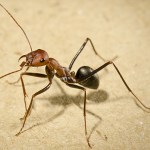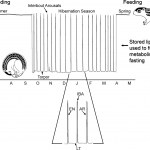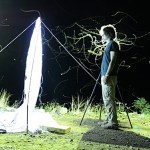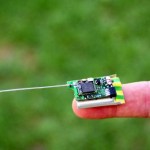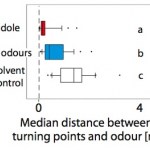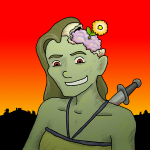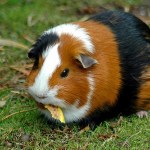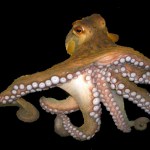navigation
I've got this press release that will be of interest to many:
An international team including researchers at the university of Edinburgh and Antoine Wystrach of the Research Centre on Animal Cognition (CNRS/Université Toulouse III—Paul Sabatier) has shown that ants can get their bearings whatever the orientation of their body. Their brains may be smaller than the head of a pin, but ants are excellent navigators that use celestial and terrestrial cues to memorize their paths. To do so, they use several regions of the brain simultaneously, proving once again that the brain of insects is more…
Dr. Vivek Jayaraman and colleagues at the Howard Hughes Medical Institute Janelia Research Campus discovered that the ellipsoid body located in the middle of a fly's brain acts like a compass to help navigate flight even in darkness. By placing the flies into a small virtual reality arena and having the flies walk on a rotating ball, they could study the activity of neurons within the ellipsoid body while the animal was moving.
These videos show how the fly experiment was done:
Check out the news release for more information about this neat study.
Image from the American Physiological Society's website.http://www.the-aps.org/mm/Conferences/APS-Conferences/2014-Conferences/…
Wednesday was the last day of the meeting that culminated in a closing banquet with an awards session to honor students who had exceptional presentations. What an impressive group of young comparative physiologists! The plenary lecture was given by Dr. Steven Chown (Monash Univ, Australia). He spoke about climate change forecasts and continuing environmental changes and how important it is to understand how animals adapt to changing conditions in order to…
Eran Levin in front of a blacklight screen.
Eran Levin, a postdoctoral researcher at the University of Arizona studies Hawk Moths. He used a technique called backlighting to catch them and in the process catches numerous other insects as well.
Moths navigate by keeping bright objects like the moon and stars at a constant angle. It turns out that artificial light disrupts the moths's detection of moonlight. They end up using the artificial light source as a navigation cue and as a result wind up circling the light bulb to keep it at a constant angle.
Check out his blog entry in Scientific…
Dr. Nachum Ulanovsky of the Weizmann Institute and Prof. Ran Nathan and Asaf Tsoar of the Hebrew University of Jerusalem have captured live fruit bats and glued tiny GPS transmitters to their backs, then driven the bats overnight to a site some 80 kilometers away and rappelled into the bats' caves to retrieve the transmitters after they fall off - all in the name of scientific research. In the process, the team has revealed how these bats form mental maps that they use to return to their favorite fruit trees night after night, often flying large distances and bypassing other, similar trees on…
A version of this post was originally published on my Wordpress blog on March 15, 2010. Click the archives image to see the original post.
Most animals, at some point in their day-to-day lives, face the same problem. After they've gone out in search of food, they need to find their way home. But some of the places where these critters live lack any real visual landmarks - like the open ocean or wide expanses of desert. Instead of relying on vision, some animals have developed the ability to use olfactory (scent-related) cues to aid in navigation. Seabirds can detect subtle changes in the…
Ernst Haeckel's Kunstformen der Natur (Artforms of Nature) was a landmark in biological illustration. Published in 1904, it was lavishly illustrated with 100 exquisitely detailed lithographic plates, including this one, showing nine different species of cubomedusae, or box jellyfish.
It has been known, since around the time that Haeckel's masterpiece was published, that box jellyfish have a unique visual system which is more sophisticated than that of other jellyfish species. They boast an impressive set of 24 eyes of four different types, which are clustered within bizarre sensory…
Imagine with me, for a moment, that the zombie invasion has begun. You try to escape, but the zombies are just too much to handle. You can't run fast enough. They're everywhere. Your favorite science bloggers have been turned into zombies and they're coming for you.
Figure 1: Thanks to Joseph Hewitt of Ataraxia Theatre for providing us with these awesome illustrations of zombified sciblings! Left to right: Christie, Sci, Bora, me, & Peter and Travis. Click on each to embiggen.
I'm sure you've always wondered what would happen as a zombie ate through your brain. How would it feel? What…
Yesterday afternoon, I watched the livestream of the "All Creatures Great and Smart" session of the World Science Festival in New York City. The session was absolutely fantastic, and featured Brian Hare, Vanessa Woods, Jeremy Niven, Patrick Hof and Klaus Zuberbühler.
The conversation challenged long-held assumptions about the differences between "animal" and "human", and included fascinating discussion about pin-sized brains that can count, categorize, and hold a grudge against those who've tried to swat them. Does your dog really think and feel like a human? Do our closest primate…
Zen recently wrote mentioned this study on his blog, so I thought it was time to dredge it out of the archives. Also, I've just returned from APS (see my daily recaps here here and here), and I am TIRED.
Domestic animals and their wild counterparts can be different in big ways; there can be differences in morphology (physical characteristics), physiology, and behavior. These changes may depend on spontaneous adaptations to captivity or to artificial selection pressures arising from the motivation for domesticating the animal in the first place.
One change that is often observed as a result of…
Say you're visiting Los Angeles and you have a sudden craving for Chinese food. Since you are only visiting, you might not be aware that nothing is open past, like, 10pm (not even coffee houses), but you get in your rental car and go driving around in search of your Chinese feast anyway. You try hitting up Panda Express, but no such luck. Of course they're closed. You try the neighborhood Chinese restaurant: closed as well. You get back in the car, and think to yourself "maybe the OTHER Panda Express will be open", but alas, it is not. You are ready to return to the hotel and just go to sleep…
It's amazing how much you can learn about an animal's mind by a simply watching it.
Video 1: Gratuitous video of octopuses never hurt anyone. Maybe this will sate the Pharyngulites.
In the late 1980s, a researcher named Jennifer A. Mather wondered about octopuses' use of spatial memory. This researcher and some volunteers did some skin-diving near Bermuda and observed octopuses going out in search of food. They noticed that sometimes after catching a tasty bit of chow, the octopuses ate out, but sometimes they'd take their snack to go and eat at home. And not only that, but it turned out…
There is a fascinating case study in Current Biology.
de Gelder et al. discuss a patient -- referred to as TN to protect his privacy -- who had two sequential strokes that damaged his brain. The parts of the brain that were damaged included the primary visual cortex in both hemispheres -- rendering the patient blind. However, the patient could still respond to some visual stimuli through a phenomenon called blindsight.
Even more interesting, the patient could still navigate around visual objects, while reporting being unable to see them and having no memory for what they were.
I have…
From David Attenborough's The Trials of Life (1990):
If you're interested in learning more about navigation in Cataglyphis, look for papers coming from the lab of Rüdiger Wehner. His group has produced a stream of really top-notch research.
